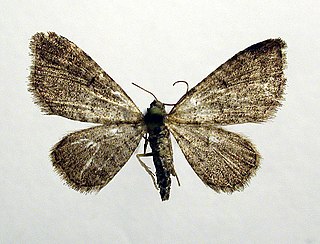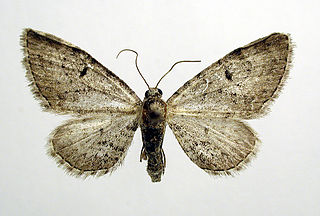
Eupithecia is a large genus of moths of the family Geometridae. There are hundreds of described species, found in all parts of the world, and new species are discovered on a regular basis.

The wormwood pug is a moth of the family Geometridae. The species was first described by Carl Alexander Clerck in 1759. It is a common species across the Palearctic region as well as North America.

The common pug(Eupithecia vulgata) is a moth of the family Geometridae. It is a common species across the Palearctic region, including the Near East and North Africa. It ranges from the Atlantic coast of Ireland and Portugal across Europe, the Middle East and Central Asia to the Russian Far East (Priamurje) and Korea.

The grey pug is a moth of the family Geometridae. It is found throughout the Palearctic region. It is also found in North America.Since it does not place any special demands on climatic conditions, special caterpillar food plants, geological subsoil or the like it is a typical species of almost any Hochstaudenflur, where it occurs in the herb layer, in bushes and even on deciduous trees. It can be found on forest edges and hedgerows, on heath, in rocky places and wetlands, parks and gardens, as well as in villages and town centres.

The tawny speckled pug(Eupithecia icterata) is a moth of the family Geometridae. It is found throughout the Palearctic region, the Near East and North Africa.

The Glypheoidea, is a group of lobster-like decapod crustaceans which forms an important part of fossil faunas, such as the Solnhofen limestone. These fossils included taxa such as Glyphea, and Mecochirus, mostly with elongated chelipeds. This group of decapods is a good example of a living fossil, or a lazarus taxon, since until their discovery in the 1970s, the group was considered to have become extinct in the Eocene. The superfamily Glypheoidea comprises five families. The two extant species, Neoglyphea inopinata and Laurentaeglyphea neocaledonica, are both in the Glypheidae.

The juniper pug or juniper looper is a moth of the family Geometridae. The species was first described by Michael Denis and Ignaz Schiffermüller in 1775. It is found throughout the Palearctic and in the Nearctic.

Banksia erythrocephala is a species of prickly shrub that is endemic to Western Australia. It has erect stems, sharply pointed pinnatifid leaves, cream-coloured and reddish black or all cream-coloured and yellow flowers, and egg-shaped fruit.
Westraltrachia inopinata is a species of air-breathing land snails, a terrestrial pulmonate gastropod mollusk in the family Camaenidae.

Helenodora is an extinct onychophoran genus known from the Carboniferous Carbondale Formation of Illinois. The only known species described is H. inopinata.

Eupithecia plumbeolata, the lead-coloured pug, is a moth of the family Geometridae. The species can be found all over Europe ranging to the Urals, then through Central Asia to Siberia and to Sayan mountains, the Altai and the Amur. In the Alps, the species occurs up 2000 metres above sea level and in the Pyrenees up to in 2400 metres.

Eupithecia venosata, the netted pug, is a moth of the family Geometridae. It was first described by Johan Christian Fabricius in 1787. It is found across the Palearctic realm from Portugal and Morocco in the west to the Lake Baikal in Siberia and Afghanistan and Pakistan in the east.

Eupithecia satyrata, the satyr pug, is a species of moth of the family Geometridae. It was described by Jacob Hübner in 1813. It is found from Ireland, through northern and central Europe east to all of Russia and central Asia and western Siberia to Tibet. It is also present in North Africa and North America.
Nitrospirae is a phylum of bacteria. It contains only one class, Nitrospira, which itself contains one order (Nitrospirales) and one family (Nitrospiraceae). It includes multiple genera, such as Nitrospira, the largest. The first member of this phylum, Nitrospira marina, was discovered in 1985. The second member, Nitrospira moscoviensis, was discovered in 1995.

Eupithecia pimpinellata, the pimpinel pug, is a moth of the family Geometridae. The species was first described by Jacob Hübner in 1813. It is known from most of Europe to Morocco, Siberia, Kyrgyzstan, Altai, Mongolia.It primarily colonizes bushy places, forest edges, clearings, hedges, mountain slopes, embankments, railway dams and parks as well as semi-dry grasslands. In the Alps it rises to heights of 1800 metres.

Neoglyphea inopinata is a species of glypheoid lobster, a group thought long extinct before Neoglyphea was discovered. It is a lobster-like animal, up to around 15 centimetres (5.9 in) in length, although without claws. It is only known from 17 specimens, caught at two sites – one at the entrance to Manila Bay in the Philippines, and one in the Timor Sea, north of Australia. Due to the small number of specimens available, little is known about the species, but it appears to live up to five years, with a short larval phase. A second species, previously included in Neoglyphea, is now placed in a separate genus, Laurentaeglyphea.
Michèle de Saint Laurent was a French carcinologist. She spent most of her career at the Muséum national d'histoire naturelle in Paris, working on the systematics of decapod crustaceans; her major contributions were to hermit crabs and Thalassinidea, and she also co-described Neoglyphea, a living fossil discovered in 1975.
Strumigenys inopinata is a species in the genus Strumigenys. It is found in Sri Lanka.
Matigramma inopinata is a species of moth in the family Erebidae. It is found in North America.












